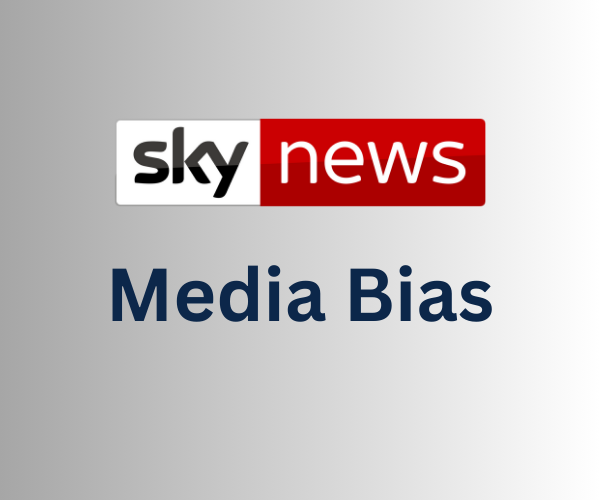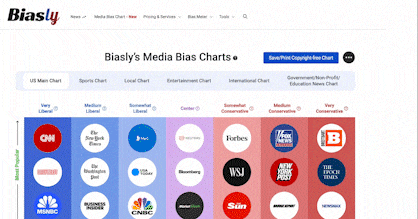
Founded by Rupert Murdoch and British Satellite Broadcasting on February 5, 1989, Sky News became the first 24-hour channel in the UK. Providing around-the-clock coverage of politics, business, and international affairs and impartial reporting, it has become a trusted source of information for viewers across the UK and internationally. Over the years, the organization has faced controversy regarding perceived biases in its news stories. In 2003, it was criticized for its coverage of the Iraq War, with detractors accusing it of biased reporting and a lack of balanced perspectives on the conflict. In 2016, it again came under fire for perceived bias in its coverage of the Brexit referendum debate.
In this article, we will examine the newspaper’s coverage and editorial choices to identify any potential biases in their articles. By equipping you with these tools, we aim to provide a comprehensive analysis that will help you determine whether a news outlet is biased.
How Does Biasly Rate News Sources?
Biasly’s algorithms produce bias ratings to help provide multiple perspectives on given articles. Biasly has analyzed 200,000+ news articles from more than 3,200 news sources through our A.I. technology and team of political analysts to find the most factual, unbiased news stories.
Biasly determines the degree of political bias in news sources by using Biasly’s Bias Meter Rating, in which Biasly’s team analyzes media sources’ reliability and bias and produces three scores, a Reliability Score that measures the accuracy of media sources; an A.I. Bias Score, evaluated by A.I.; and an Analyst Bias Score evaluated by political analysts. These scores are rated based on seven rating metrics including Tone, Tendency, Diction, Author Check, Selection/Omission, Expediency Bias, and Accuracy. These metrics help our analysts to determine the political attitude of the article.
Our A.I. machine-learning system employs natural language processing and entity-specific sentiment analysis to examine individual articles and determine their bias levels. By analyzing the key terms in an article such as policies, bias phrases, political terminologies, politicians, and their nicknames, the algorithms can rate the attitude of the text. Bias scores range from -100% and 100%, with higher negative scores being more liberal and higher positive scores being more conservative, and 0% being neutral.
Is Sky News Politically Biased?
Biasly’s rating for Sky News gives the paper a Computer AI Bias Score of Center, a score generated by its AI-based algorithms. Biasly’s AI bias analysis focuses on the leaning of tone, opinion, and diction of the author, and their respective tendencies. For example, Biasly has rated its stance on policies such as Free College Education and Gun Control as centered.
Biasly has assigned a Somewhat Liberal as an Analyst Bias Score. Typically, alongside the Computer Bias Score, Biasly presents an Analyst Bias Score. This score is curated based on a review of at least 15 articles by a team of analysts representing liberal, moderate, and conservative viewpoints. Different types of bias in articles, preferences for liberal or conservative politicians and policies, all factor into generating these scores. The more articles the Biasly analyst team reviews and rates, the more precise the analyst score becomes.
Before we begin, we need to discuss bias. Bias is a natural function of humans, and we can express it both consciously and unconsciously. Bias is one of the most fundamental forms of pattern recognition in humans. This isn’t to lower the bar and say that “all things are biased,” but to explain the process in which we may come to trust certain news organizations that display patterns of coverage.
On the media’s part, there is an incentive to retain audiences, encourage them to purchase subscriptions, and rate products positively. Bias is a two-way street, people want to see news stories about things they care about, and the media needs viewers to continue their operations. This creates a positive feedback loop that influences what stories are covered and from what perspective. This also explains the actions of more liberal news organizations.
Analysis of Bias in Sky News Online Articles
Understanding Sky News’s target audience demographics is crucial for grasping how the company tailors its content. Given its influence in the United Kingdom and beyond, its audience’s political affiliations and ideologies can vary by country or region. According to Pew Research, 55% of adults in the UK generally trust Sky News, with 49% of left-wing individuals and 59% of right-wing individuals expressing this trust.

Source: Pew Research Center
Sky News has an older audience than other news channels, particularly among viewers aged 35 to 64. The gender balance among its viewers is relatively equal, comprising both male and female audiences. Additionally, it attracts individuals with college degrees who typically come from middle to upper-income brackets. While the audience is predominantly conservative, Sky News caters to viewers with right-leaning and independent perspectives. Given its specific audience, how does Sky News ensure its impartial content appeals to liberal and conservative readers worldwide?
When determining bias, some of the most common metrics used include Tone, Tendency, Author, Diction, and Expediency Bias, which are the primary metrics we’ll focus on below.
- Tone: This represents the attitude of the writing, formed distinctively but related to the author’s word choices or diction.
- Diction: The specific words chosen by the writer.
- Author: A metric related to the article’s author, taking into account their history of stance on issues based on past articles and social media posts.
- Tendency: measures how consistently an author shows bias in their work, including factors like their tone and perspective.
- Expediency Bias: relates to the immediate impression created by elements like the article’s headline, images, or summary, indicating if they favor a particular viewpoint.

An example of this is “George Clooney calls on Biden to drop out of presidential race to give Democrats chance of beating Trump”. The expediency bias is within the headline as it indicates the pressure for Joe Biden to decide to run for a second term in the White House due to concern about his age and performance. The article’s headline and content create an immediate impression that supports the idea of Biden stepping down.
The author’s tone expresses urgent concern about Joe Biden’s ability to win the election and its effects on the Democratic Party.
“We’re all so terrified by the prospect of a second Trump term that we’ve opted to ignore every warning sign. The George Stephanopoulos interview only reinforced what we saw the week before.
The author tends to show bias against Biden, but yet still leans liberal, using a critical tone and perspective to express concerns about his performance and suitability for a second term in the White House. The diction is direct and urgent, as evidenced by George Clooney’s statement about President Biden’s performance. He describes it as “devastating” and emphasizes that Biden remains “the same man we all witnessed at the debate.” These words are deliberately chosen to stress the seriousness of the situation, suggesting that Biden’s candidacy and performance could lead to dire consequences.
Regarding the author’s bias, James Matthews is a US correspondent for Sky News, based in Washington. His X (Twitter) account does not disclose many personal opinions on politics. Instead, his feed primarily features video clips of his coverage of US political news, along with reposts of interviews and reports from his colleagues at Sky News.
Prime Minister Keir Starmer will meet President Joe Biden today to discuss supporting Ukraine, focusing on whether to allow Western missiles to target Russia.@jamesmatthewsky has all the details.https://t.co/PAiZ4D1jU3
📺 Sky 501, Virgin 602, Freeview 233 and YouTube pic.twitter.com/X8h2ZB4bfT
— Sky News (@SkyNews) September 13, 2024
It’s less than a month to go until the US election.@marthakelner is in the swing state of Arizona, and with Hurricane Milton hitting Florida, @jamesmatthewsky & @Stone_SkyNews are in Sarasota and St Petersburg, discussing the impact of misinformation.
— Sky News (@SkyNews) October 11, 2024
Analysis of Sky News Opinion Articles
Before addressing this question, it is essential to distinguish between reporting and opinion. Reporting is intended to be neutral, focusing on presenting facts and quotes from primary sources so that readers can form their own opinions. In contrast, opinion articles provide columnists with a platform to express their personal views on current issues. While Sky News strives to maintain neutrality as a publication, it also features an Opinion section where columnists can share their perspectives. However, their Opinion section appears significantly outdated, with the last entry posted on May 2023.
Consider the Opinion article posted in June 2020, “Racism won’t change until black people no longer seen as police ‘property’ – former Met diversity chief”. The language of the title is direct and confrontational, using strong words like “racism” and “policy property” to immediately capture the reader’s attention and evoke strong emotions. The tone suggests urgency and a call for change, which may attract readers who are passionate about social justice issues. Additionally, referring to the “former Met diversity chief” lends credibility to the perspective, encouraging readers to take the argument seriously and reflect on the systemic nature of the problem. However, the title’s phrasing might alienate some readers who perceive the language as overly accusatory or one-sided, which could affect their view of the article’s bias.
In the article, the author argues:
“Yet, for black people, evolving changes in the language and style of UK policing are shifting towards more of an “enforcement” style than “service””
“The answer is to stop stereotyping black people as low status, unintelligent, aggressive, dangerous, self-destructive, and sub-human.”
“Every person advocating for change must make a commitment to empty the police “property” list so black people and others subjected by the majority to negative stereotyping as “low status” do not die in police custody.”
“If we are genuinely going to address racism and its destructive effects, every one of us needs to look at ourselves and ask: what do I need to do to take black people off the police “property” list?”
The author’s language is assertive and unyielding, choosing words that emphasize the gravity and urgency of the issue, such as “enforcement” and “sub-human, directly challenging readers to confront uncomfortable truths. Consequently, the unequivocal stance, terminology, and tone may alienate those who share a different perspective or feel the article needs a balanced viewpoint. The perceived bias in presenting police practices as inherently problematic may alienate those who support law enforcement or believe in a more balanced view, potentially limiting the article’s reach to a broader audience.
Another example is an opinion article from Sky News is “Trump’s reckless Middle East rampage makes mad Bush’s rush to war look thoughtful”. The title of the article employs provocative and charged language, featuring words like “reckless,” “rampage,” and “mad,” which evoke a sense of chaos and responsibility. By comparing Trump’s actions to those of Bush, the article creates a dramatic contrast that engages readers and prompts them to reflect on the seriousness of the situation.
In the article, the author claims:
“America continues to pay a huge price for Republican misadventures in the region.”
“And like Bush’s long-lost Iraq War, Trump’s thoughtless drone strike will likely mark an extended period of US turmoil for American forces and their standing in the region.”
“If extremists like Pompeo and Pence want Trump to create chaos in the Middle East in order to quicken the Rapture, they ought to just say so and let swing state voters this year decide if that’s America’s best path forward.”
Both examples use charged language to provoke strong emotional reactions from readers, effectively engaging those who already share similar viewpoints. However, this approach can alienate individuals with opposing views or those who prefer a more nuanced discussion. The police reform article challenges readers to confront systemic racism directly, while the opinion piece on Trump’s Middle East policy employs vivid comparisons to critique political decisions. Both pieces emphasize the urgency and seriousness of their respective issues but may limit their reach to audiences that are receptive to such direct criticism.
Who Owns Sky News?
Sky News is owned by Sky Group, a subsidiary of Comast Corporation, a prominent American telecommunications conglomerate that owns various media properties, including NBCUniversal and Xfinity. Operating across six European countries, Sky connects over 23 million customers worldwide to offer a wide range of digital products and services, including television, radio, and online streaming.
Dana Strong is the current Group Chief Executive Officer of Sky. Before joining Sky, she served as Chief Operating Officer at Virgin Media starting in 2013 and became Senior Vice President and Chief Transformation Officer at Liberty Global in 2015. In 2018, she was President of Consumer Services for Comcast Cable before succeeding Jeremy Darroch as Sky’s chief executive in 2021. Strong has fostered long-term partnerships between Sky and UK public service broadcasters, such as Channel 4 and the BBC (Center). Furthermore, she has established agreements with Apple TV+ and Paramount+ to integrate their content into Sky’s Entertainment OS platform.
How to Evaluate and Uncover Bias
It can be challenging to determine whether the news you consume is biased. When you choose a news channel, it is often because you trust the information. Unfortunately, many people trust sources that simply confirm their preexisting beliefs, a phenomenon known as “confirmation bias.” It is essential to challenge your beliefs and seek third-party verification to ensure that you are getting a complete understanding of the story. We recommend using Biasly to compare news articles side-by-side, utilizing our AI bias ratings to understand the perspectives surrounding a political issue.
Although Biasly has given Sky News a Center bias score, the bias can vary from article to article. Sky News does not exclusively publish content that favors one side; it has produced leftist and conservative opinion pieces. Consequently, some articles will exhibit more bias, with general news articles typically being less biased than opinion pieces. Every article you read will have some degree of bias. Some articles adhere more closely to the facts than others, so it is crucial to use Biasly’s News Check to assess the bias of what you read.























